Keeping birds away from your newly planted grass seed is key. They love to eat the seeds, potentially ruining your lawn’s look. We’ll share 15 ways to ward off birds without hurting them. These methods include using decoys, sprinklers that detect motion, liquids that scare birds off, and special seed coatings.
You can also try putting up barriers like nets and using shiny objects. Plus, offering bird feeders as a distraction is a good idea. By trying these tactics, you’ll safeguard your new lawn and help the grass grow well.
Key Takeaways
- Utilize a variety of bird deterrents to protect your grass seed from being eaten
- Motion-sensing sprinklers and reflective objects can effectively scare away birds
- Provide alternative food sources like bird feeders to distract birds from the grass seed
- Cover grass seed with mulch, netting, or burlap to physically block birds from accessing it
- Consider using fast-growing grass seed varieties to minimize the impact of bird damage
Introduction: Why Birds are Attracted to Your Lawn
Birds come to your newly seeded lawn for two main reasons. First, lots of tasty seeds are perfect for them. Second, the wide open space and nearby trees or buildings make a great place for them to nest. Knowing this, we can find ways to protect our grass seeds from hungry birds.
The Allure of Seeds: A Bird’s Buffet
Birds love grass seeds because they are full of energy and protein. In places like Dorset, East Anglia, and the Welsh Marches, quails really enjoy these seeds, eating as much as they can. You’ll also find sparrows, finches, starlings, and pigeons joining the party, eating all the fresh seeds they can find.
Nesting Grounds: Warm and Secure
Your lawn is not just a food source for birds, it’s also great for nesting. The space and nearby trees or buildings are ideal for birds to build their homes. This turns your newly seeded lawn into a cozy spot for birds to nest and raise their babies.
To protect your grass seeds, it’s important to understand why birds are attracted to your lawn. Make your lawn less appealing by both preventing their feeding and nesting. You can also use methods that scare them away to save your investment.
How to Identify Bird Damage on Your Lawn
Seeing small holes, around 1-1.5 inches, means birds might be eating your grass seed. They make these holes in lawn from birds by digging for seeds. You might also notice spotty grass and bird droppings. Catching these signs of birds eating grass seed early helps stop further damage.
Birds are quick to spot food, including your newly seeded lawn. They can see motion up to 40-60 feet away. This makes it hard to keep them off your property. But knowing how they act lets you fight back and keep your lawn healthy.
| Symptom | Description |
|---|---|
| Small Holes in Lawn | Birds create 1-1.5 inch diameter holes in the soil to extract grass seeds. |
| Sparse, Uneven Grass Growth | Areas with missing or damaged grass indicate where birds have been feeding. |
| Bird Droppings and Feathers | The presence of bird droppings and feathers on the lawn are telltale signs of avian visitors. |
If you know the signs of birds eating grass seed, you can protect your lawn. Being alert and early intervention are crucial. They help in keeping your lawn beautiful and free from bird damage.
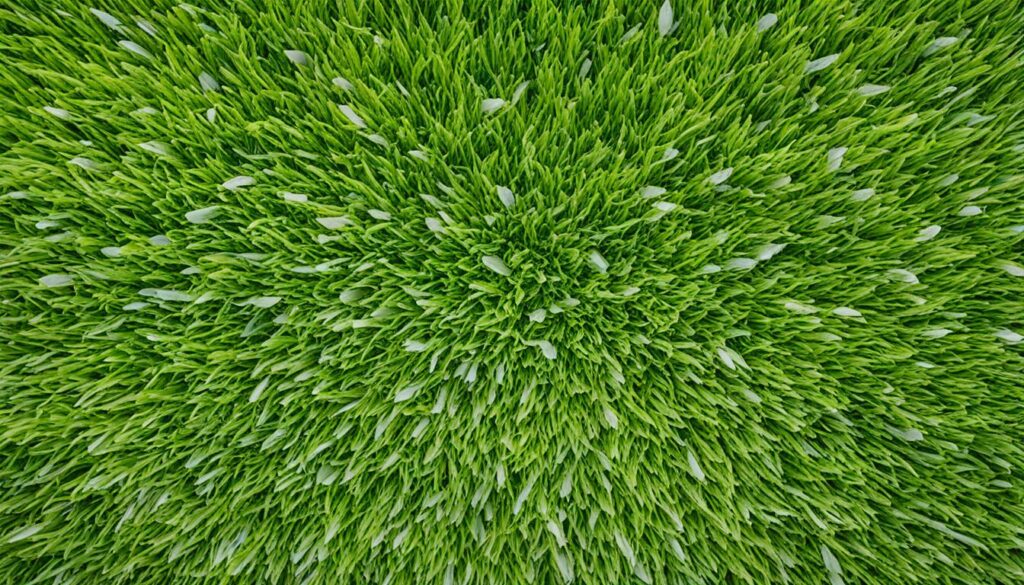
Deter Birds with Fake Predators
Want to keep birds off your lawn? Try using fake predators. These include rubber snakes, plastic owls, or scary motion-activated decoys. They make birds think there’s danger nearby, so they fly away. Place these fake predators around your lawn wisely. Their movement or sound scared the birds even more.
Motion-Activated Owls and Snakes
Devices like motion-activated owls and snakes work really well. When they sense a bird, they make a noise or move. This startles birds visually and makes them feel unsafe near your lawn.
- Bigger fake snakes scare more because of their size.
- Since snakes eat birds, birds naturally avoid them.
- For owl decoys, keep moving them. Birds notice if they stay still too long.
Realistic rubber snakes and eye-shaped balls can also scare birds off. Birds think these items look like predators, so they stay away.
“Farmers have been using scarecrows for many generations to scare crows away from the corn crop.”
To prevent birds from harming your lawn, use fake predators. Place motion-activated owl decoys and snake replicas where they can work well. This will help protect your grass and seeds from bird pests.
Motion-Sensing Sprinklers: A Watery Deterrent
Motion-sensing sprinklers are great for keeping birds away from your new lawn. They spray water when birds come close. This surprises them and stops them from eating your grass seed.
These sprinklers are awesome because they cover a big area, usually 40 to 60 feet. Birds can’t easily get to your lawn without them getting sprayed. Even the cheaper models, with a 30-foot range, do a good job.
They work by spraying water when birds approach. This surprises and bothers the birds, so they learn to stay away. Plus, the wet environment makes it less inviting for birds to nest there.
You should place these sprinklers carefully. Put them around the edges of your lawn or where birds often gather. This creates a shield that keeps your lawn safe from bird damage.
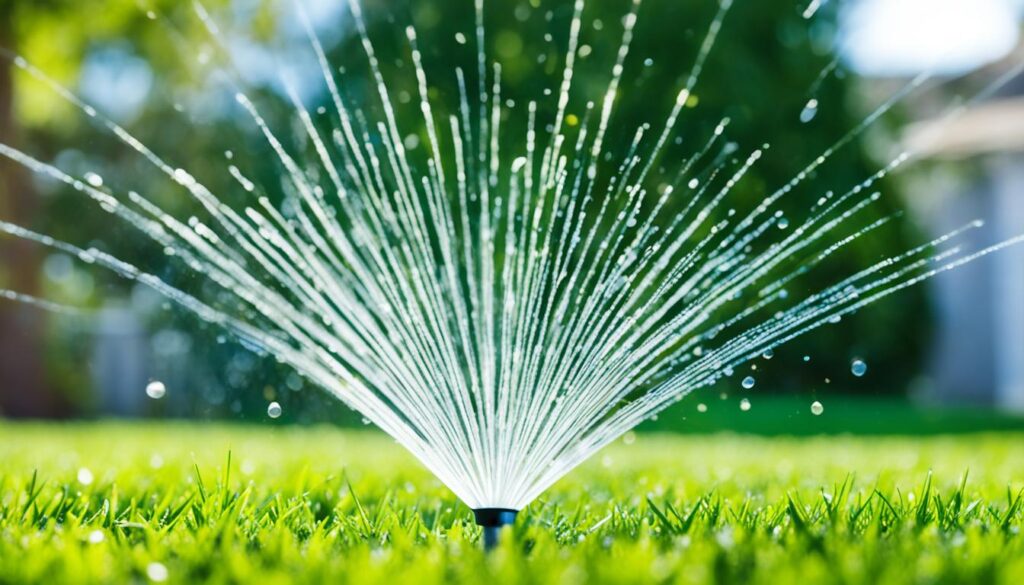
Choosing a fast and consistent motion-sensing sprinkler system is the key. It will protect your grass seed well. So, you won’t have to worry about birds eating it.
Spray Bird-Repellent Liquids
To keep your grass seed safe from birds, consider using commercial bird-repellent sprays. They have ingredients like aluminum ammonium sulfate. These make the grass seed taste bad, so birds won’t eat it.
These bird repellent sprays for grass seed are effective. They make birds look for food somewhere else. This way, your lawn stays bird-free and your seed is protected.
Commercial and DIY Options
There are many bird repellent sprays for grass seed to choose from. Each has its own mix of ingredients. Avian Control™ covers a big area while Avian Migrate protects smaller lawns but requires less product.
Avian Fog Force™ TR Bird Repellent lasts for about 30 days. This product works in bigger areas. It’s in an aerosol can that covers up to 42,000 cubic feet.
If you like making things at home, you can DIY bird-repellent sprays. Use things like black tea or peppermint oil mixed with water. Spray this on your lawn. Birds will not like the taste and will go somewhere else to eat.
Whether you go for commercial or DIY, bird-repellent sprays are great. They help keep birds away from your grass seed. Regular use of these sprays will protect your newly seeded lawn.
“After using the bird-repellent spray, we noticed a 100% reduction in bird presence on our lawn. It’s a game-changer for protecting our grass seed investment.”
– Satisfied Homeowner
Use Bird-Repellent Grass Seed
One way to protect your lawn from birds is by using special grass seed. This seed has a bird-resistant coating. The coating is bitter, so birds don’t like the taste. However, it won’t hurt the grass’s growth. Even when watered, this coating still works well. This helps your lawn stay safe while the new grass grows.
These special grass seeds are not tasty to birds. So, they won’t eat your new grass. Using this seed lowers the chance of birds ruining your lawn to find food. The seed is made to taste bad or feel weird in a bird’s beak. This keeps birds away and lets your grass grow smoothly.
When buying bird-resistant grass seed, choose ones with clear bird-deterring features. The coating might use natural or man-made ingredients. For example, it might have capsaicin, the hot stuff in chili peppers. This way, you keep birds off your new grass. You get to have a green, bird-free yard to enjoy.

“Using bird-repellent grass seed is a simple and effective way to protect your lawn from bird damage, allowing your new grass to grow undisturbed.”
How well bird-repellent grass seed works depends on a few things. The size of your lawn, the types of birds in your area, and the weather matter. Be sure to use the seed as the instructions say. Also, adding more bird-deterrents can help a lot.
Cover with Straw Mulch or Burlap Sheets
Covering newly planted grass seed helps keep birds away. Straw mulch is a great choice. It makes getting to the seeds hard for birds. It also helps keep moisture in the soil and fights off weeds.
Burlap sheets are another good option. They are a natural fabric that’s loosely woven. They let sunlight and water through but keep birds away. Both straw mulch and burlap are good ways to stop birds from eating your grass seed.
- Straw mulch creates a physical barrier that makes it harder for birds to reach the grass seed.
- Burlap sheets act as a permeable barrier, blocking bird access while still allowing sunlight and water to reach the seed.
- These physical barriers provide an effective deterrent against birds eating your newly planted grass seed.
When you use straw mulch or burlap, spread them out smoothly and keep them at the right depth. This way, the grass seed can still grow. The goal is to keep birds away without stopping the seed from sprouting and growing.
“Covering grass seed with a layer of straw mulch or burlap sheets is a simple and effective way to prevent birds from accessing and eating the seed.”
Using these barriers can keep birds from your grass seed. This gives your lawn a better chance to grow well.
how to keep birds from eating grass seed with Netting
It can be hard to stop birds from eating your new grass seed. But bird netting works well. This special net covers the ground where seeds are. It keeps birds away without hurting them.
Setting up the net above the ground is important. It stops birds from reaching the seeds. This way, your grass can grow safely and birds like sparrows and pigeons won’t get to eat the seeds.
Netting is a good, safe way to protect your grass seeds. You can use things like stakes to hold it down. This stops birds from sneaking in under the net to eat the seeds.
| Advantages of Using Bird Netting | Disadvantages of Using Bird Netting |
|---|---|
|
|
Think about the good and bad of using bird netting. If you put it up right and check it often, your new grass will grow safe from birds.
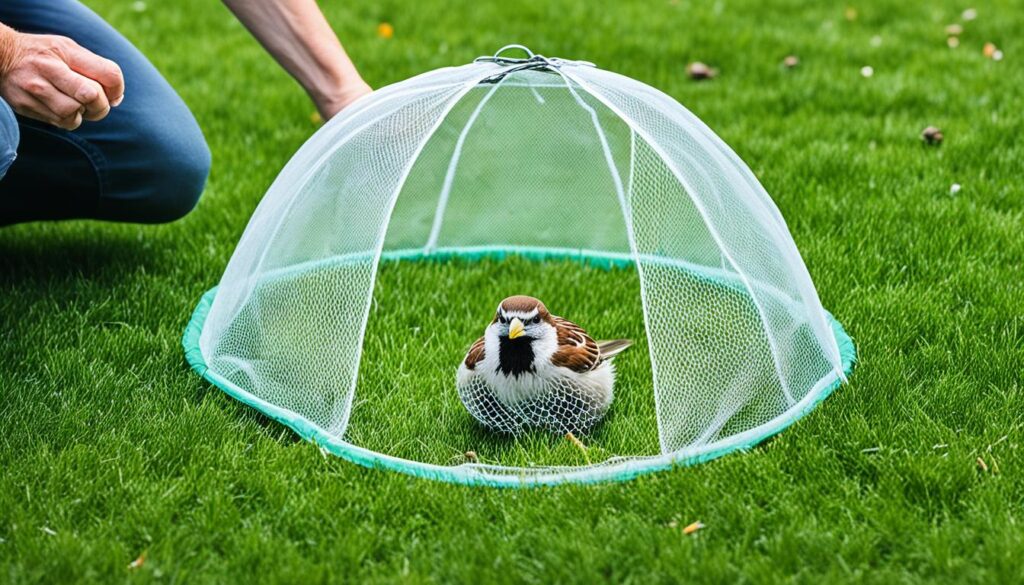
“Netting is a game-changer when it comes to protecting your grass seed from hungry birds. It’s a simple, yet highly effective solution that can save your lawn from being ravaged.”
Install Mirrors and Reflective Surfaces
It’s not easy keeping birds away from your grass seed. But, using mirrors and shiny things can really help. When birds see their reflection or shiny objects, they get scared.
You might place small mirrors or foil in the areas you’ve seeded. This uses the light to confuse the birds. The light moves with the wind, creating shadows that birds don’t like.
Here are some options for scaring birds off:
- Reflect-a-Bird: A spinning bird deterrent that works on wind power.
- Scare Eye Diverters: Bird deterrents that look like they have scary eyes.
- Scare Balloons: Colorful and shiny balloons that scare birds off.
- Holographic Flash Tape: A type of tape that scares birds with light.
- Scare Bird Garden Stakes: Bird deterrent stakes with shiny eyes.
For the best results, switch the placements of these things from time to time. This keeps the birds from getting used to them. By using mirrors and shiny objects, you can protect your grass seed well.
“Visual bird deterrents, such as bird reflectors, are cost-effective solutions for pest bird problems.”
Use Bird Tape and Brightly Colored Flags
Keeping birds off your lawn means using different methods. A great way is with holographic bird deterrent tape and vibrant, colorful flags. These tools make your lawn less welcoming to birds.
The holographic bird deterrent tape shines and moves in the wind. When it does, it reflects light and scares birds. It also makes a sound that helps keep them away.
Besides tape, brightly colored flags or pinwheels are also good. They’re bright and move in the wind. This makes your lawn a place birds won’t want to be.
Using both holographic bird deterrent tape and colorful flags is a strong bird-repellent plan. It protects your lawn while looking nice. This way, you save your grass seed from hungry birds.
| Product | Price | Key Features |
|---|---|---|
| Premium Quality Bird Deterrent Reflective Scare Tape | $13.40 | Holographic design, reflective, generates rattling sound |
| Colorful Paper Flags | $9.99 | Vibrant colors, flutter in the wind, create visual and auditory cues |
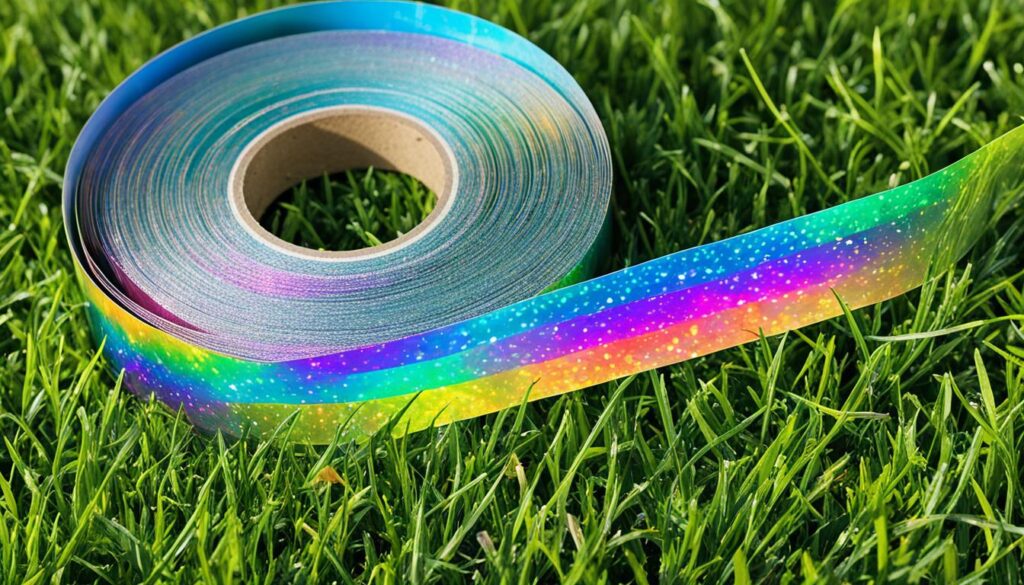
“Utilizing a combination of visual and auditory deterrents is key to effectively keeping birds away from your lawn and protecting your grass seed investment.”
Install a Bird Feeder as a Distraction
Installing a bird feeder is a smart way to keep birds off your grass seed. It works as a different food spot, pulling them away from your lawn. Common birds like crows, pigeons, and robins will be less interested.
Place the feeder away from where you’ve seeded and use foods birds love, like millet or sunflower seeds. Keep the feeder full to hold the birds’ interest. This keeps them from going after your grass seed.
Birds need water and might see your yard as a spot to drink or bathe. Offering fresh water in a birdbath can help keep them from your lawn. Remember, use only fresh water as birds avoid saltwater.
| Food Preference | Suitable for Attracting |
|---|---|
| Millet | Sparrows, Finches, Juncos |
| Sunflower Seeds | Chickadees, Nuthatches, Woodpeckers |
| Suet | Woodpeckers, Nuthatches, Titmice |
| Nyjer Seed | Finches, Siskins, Redpolls |
Placing a bird feeder smartly, with the right food, can keep birds away from your lawn. This way, your grass can grow without being pecked or disturbed.
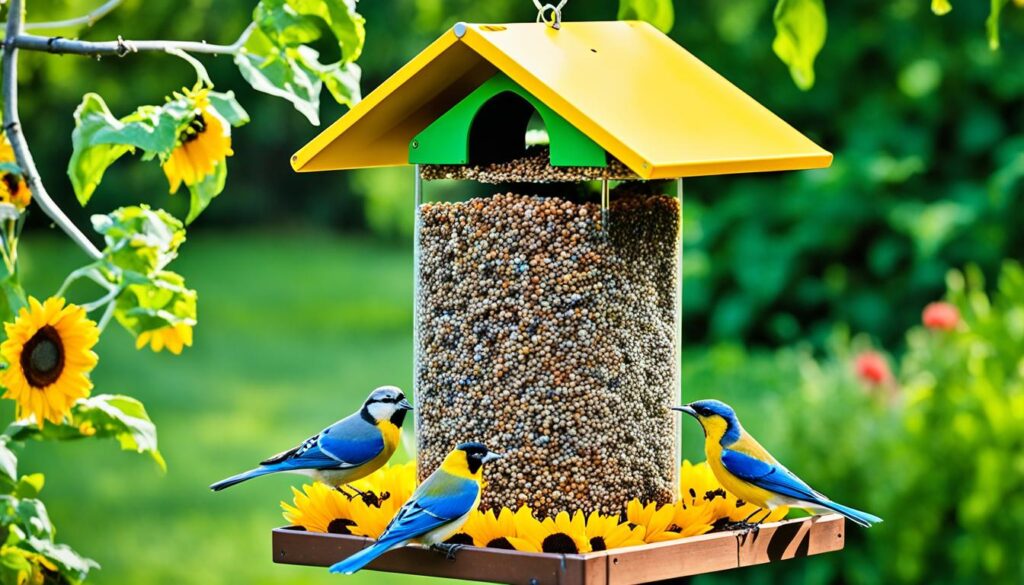
Disinfect the Lawn to Remove Food Sources
To stop birds, you can do things that make it hard for them to land. You can also ditch food they love near the front lawn. Birds like worms and bugs, but using safe sprays can get rid of these snacks. By doing this, birds will find your lawn less yummy, especially if you’re growing new grass.
Things like grubs, ants, and earthworms are lunch for birds. If you use sprays to get rid of these pests, you’ll make your lawn a less tasty spot. A smart mix of using sprays and other tactics can keep your new grass safe from bird bites.
| Bird Species | Attraction to Lawn Pests |
|---|---|
| Pigeons | Attracted to grass seeds and found in urban areas, consume a variety of foods including grass seeds and cereal seeds. |
| Buntings | Small passerine birds in North America, eat insects, spiders, and grass seeds. |
| Starlings | Common in North America, consume insects, small birds, and sometimes grass seeds. |
| Goldfinches | Global inhabitants including North America, Europe, and Asia, feed mainly on seeds including grass seeds. |
| Cardinals | In North America, feed on insects, spiders, and sometimes grass seeds. |
To make birds look elsewhere, control the bugs and worms in your lawn. Using sprays on these pests makes your lawn a place birds are less likely to hang out. This keeps your new grass safe from hungry birds.
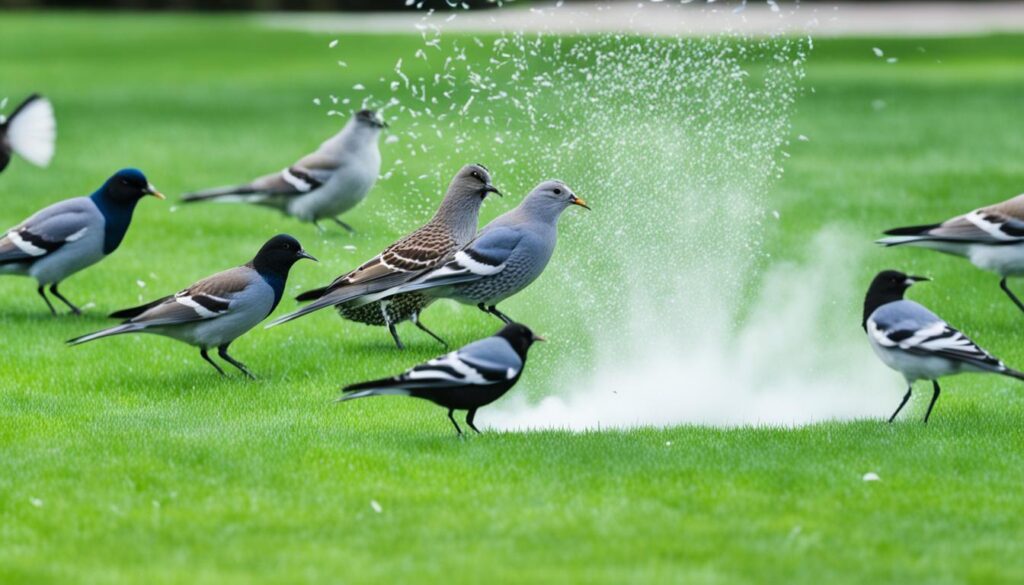
“Keeping your lawn free of potential food sources is a crucial step in deterring birds and protecting your grass seed investment.”
Conclusion
It’s important to protect your lawn from bird damage to keep it healthy and green. You can use a variety of methods to keep birds away from your grass seed. Fake predators, motion-sensing sprinklers, and bird-repellent liquids are useful.
Netting and reflective surfaces also work well. Additionally, bird feeders can distract them. It’s best to use a mix of these strategies to keep birds off your lawn. This way, you avoid harming birds while protecting your grass seed.
Birds can ruin your lawn by eating the seed, which leads to patchy areas. To avoid this, use multiple bird deterrents. Stay updated on the best ways to keep birds away.
This approach will help you enjoy a beautiful lawn, free of damage. Your property will look great without the need for costly repairs. Proactive measures against birds will ensure your lawn remains lush for years.
FAQ
What are the main reasons birds are attracted to newly seeded lawns?
Birds like freshly seeded lawns for two key reasons. First, they find a lot of food in the seeds. This makes the lawn like a buffet for them. Second, the open space is great for building nests or raising their young because there are trees or structures nearby.
How can I identify if birds are eating my grass seed?
If birds are eating your grass seed, you might see small holes on your lawn. These holes are about 1-1.5 inches wide and are made by birds looking for seeds. You might also notice areas of the grass not growing well and find bird droppings or feathers.
How can I use fake predators to deter birds from my lawn?
Scaring birds with fake predators can work. Use things like rubber snakes or plastic owls. They make birds think there are real dangers around and keep them from landing on the grass. Place them in different parts of your lawn to be more effective.
How do motion-sensing sprinklers work to keep birds away?
Motion-sensing sprinklers are a high-tech way to scare birds. They detect birds and spray water. This startles the birds and keeps them away. They can cover quite a big area, up to 60 feet.
What types of bird-repellent liquids can I use to protect my grass seed?
There are bird-repellent liquids you can buy that work well. They taste bad to birds but don’t hurt them. You can also make your own by mixing things like water with black tea or peppermint oil.
How can I use physical barriers to keep birds from eating my grass seed?
You can cover the seed with straw mulch. This makes it hard for birds to get to the seeds. It also helps keep in soil moisture and stop weeds from growing. Another option is to lay down burlap over the seeded area.
How can bird netting help protect my grass seed?
Bird netting is a good way to physically keep birds off the seed. Stretch it over the grass. Be sure to do it high enough that birds can’t reach through.
How can reflective surfaces and colorful deterrents scare birds away?
Bright, shiny things can scare birds. Placing small mirrors or foil pieces around your lawn can help. Also, bird tapes and flags with bright colors and moving patterns work well to keep birds off.
How can installing a bird feeder help protect my grass seed?
A bird feeder can draw birds away from your grass seed. Put it far from the seeded areas and fill it with food birds love. This way, birds will focus on the feeder and not on your lawn.
How can I make my lawn less appealing to birds?
To make your lawn less appealing, remove things that attract birds. Use insecticides to get rid of bugs. This way, there’s less food for birds, making them less interested in your lawn.


May I just say what a comfort to find someone who actually knows what they are talking about
on the net. You certainly know how to bring an issue to light and make
it important. More people really need to read this and understand this side of your story.
I was surprised you’re not more popular given that you definitely possess the gift.
Here is my blog; nordvpn coupons inspiresensation; t.co,